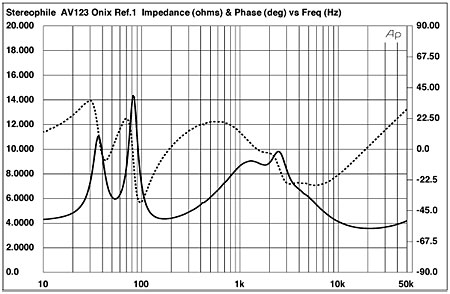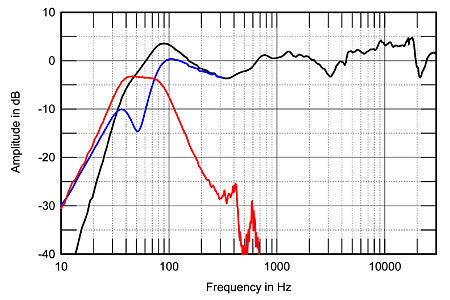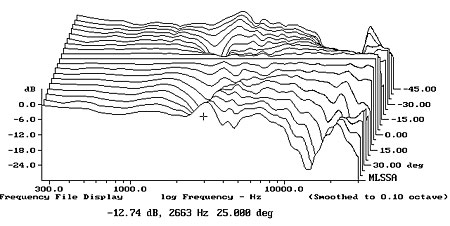| Columns Retired Columns & Blogs |
AV123 Onix Reference 1 Mk.II loudspeaker Measurements
Sidebar 3: Measurements
The Onix Reference 1 Mk.II's "efficiency" or more correctly, voltage sensitivity, is specified as "88dB." My B-weighted estimate on the speaker's tweeter axis was within experimental error of that figure, at 87.5dB(B)/2.83V/m, which is typical of a speaker in this size and price category. The speaker's impedance stays between 4.5 and 8 ohms for most of the audioband, with minima of 4.2 ohms in the lower midrange and 3.7 ohms at 20kHz (fig.1, solid trace). With an electrical phase angle that remains moderate almost all the time (fig.1 dotted trace), the Onix Ref.1 will be fairly easy to drive.

Fig.1 AV123 Onix Reference1 Mk.II, electrical impedance (solid) and phase (dashed). (2 ohms/vertical div.)
There is a small glitch just above 400Hz in the impedance traces; investigating the cabinet's resonant behavior with an accelerometer uncovered a major vibrational mode at 418Hz that was present on all surfaces (fig.2). Bob Reina didn't note any midrange coloration that could be laid at the feet of this problem; nevertheless, the resonance is strong enough and affects a sufficiently large radiating area that I would have expected it to be audible. I do wonder if it was this, rather than the Onix's lower-frequency behavior, that led Bob to feel that Jerome Harris's acoustic bass guitar and Billy Drummond's bass drum on my Rendezvous recording sounded "a tad warm," though the resonance is a little too high in frequency to have exactly this effect.

Fig.2 AV123 Onix Reference1 Mk.II, cumulative spectral-decay plot calculated from output of an accelerometer fastened to center side panel (MLS driving voltage to speaker, 7.55V; measurement bandwidth, 2kHz).
The saddle centered on 52Hz in the impedance magnitude trace suggests that this is the tuning frequency of the rear-facing port. Measured in the nearfield, the woofer does have the expected minimum-motion notch in its output at this frequency (fig.3, blue trace). However, the port's output (fig.3 red trace) does cover a slightly wider bandpass than usual. Commendably, its upper-frequency rolloff is free from the high-level resonances that are often seen in a port's response. The black trace below 300Hz in this graph shows the complex sum of the woofer and port outputs, taking into account both acoustic phase and the different distances of each radiator from a nominal farfield measuring position. The apparent peak in the upper bass is mainly an artifact of the nearfield measurement technique, but the woofer tuning does seem a touch underdamped. As BJR noted, lower-frequency instruments seemed "a bit rounded at the bottom," and this tuning would also have contributed to the warmth he noted on Rendezvous.

Fig.3 AV123 Onix Reference1 Mk.II, anechoic response on tweeter axis at 50" without grille (black), averaged across 30° horizontal window and corrected for microphone response, with nearfield responses of woofer (blue) and port (red), plotted in the ratios of the square roots of their radiating areas below 300Hz and 1kHz, respectively, and the complex sum of their nearfield responses plotted below 300Hz (black).
Higher in frequency in fig.3, which was taken with the grille removed, the Onix Reference 1 features a response that fairly smoothly but consistently tilts up with increasing frequency. There is a slight depression in the presence region that might ameliorate the bright balance, but I note that Bob Reina preferred the Onix's sound with the speaker's grille on. Fig.4 shows the effect on the response shown in fig.3 by adding the grille: While there are some peaks and dips that are the result of reflections of the tweeter's output from the grille's bulky frame, the energy level in the mid treble and top octave drops by a couple of dB. Fig.5 shows the overall response with the grille averaged across a 30° horizontal window centered on the tweeter axis. Although the top octave is still a couple of dB too hot, which might have contributed to Bob finding marimba to sound a little too "metallic," the treble region is now in better balance with the upper midrange. However, the price paid is that the presence-region suckout has been deepened, and the early reflections from the grille will interfere with imaging precision.

Fig.4 AV123 Onix Reference1 Mk.II, effect on response in fig.3 of adding grille (5dB/vertical grille).

Fig.5 AV123 Onix Reference1 Mk.II, anechoic response on tweeter axis at 50" with grille, averaged across 30° horizontal window and corrected for microphone response, with the complex sum of the woofer and port nearfield responses plotted below 300Hz
Fig.6 shows the AV123 Reference 1's horizontal dispersion, with the tweeter-axis response subtracted from each off-axis response so that just the differences are displayed. There appears to be the usual off-axis flare evident at the base of the tweeter's passband, but if this graph is compared with figs.3 and 5, this flare coincides exactly with the on-axis suckout. In normal-sized rooms, the Onix's in-room treble balance will be more neutral than the on-axis response suggests. In the vertical plane (fig.7), a deep suckout appears in the crossover region more than 5° above and 15° below the tweeter axis, while the on-axis presence-region suckout does fill in somewhat 5° below the tweeter. Tall rather than short stands will work best with these speakers—don't sit with your ears above the tweeter.

Fig.6 AV123 Onix Reference1 Mk.II, lateral response family at 50", normalized to response on tweeter axis, from back to front: differences in response 90–5° off axis, reference response, differences in response 5–90° off axis.

Fig.7 AV123 Onix Reference1 Mk.II, vertical response family at 50", normalized to response on tweeter axis, from back to front: differences in response 45–5° above axis, reference response, differences in response 5–45° below axis.
Turning to the time domain, the Onix Reference 1's step response on the tweeter axis (fig.8) indicates that both drive-units are connected with the same positive acoustic polarity. The very slight discontinuity as the decay and overshoot of the tweeter's sharply defined step blends into the slower rise of the woofer's step confirms that the optimal integration of these two drive-units' outputs occurs just below the tweeter axis. The farfield cumulative spectral-decay plot (fig.9) is very clean overall, though what is probably a residual woofer-cone breakup mode results in a slight ridge of delayed energy at 4.6kHz.

Fig.8 AV123 Onix Reference1 Mk.II, step response on tweeter axis at 50" (5ms time window, 30kHz bandwidth).

Fig.9 AV123 Onix Reference1 Mk.II, cumulative spectral-decay plot on tweeter axis at 50" (0.15ms risetime).
The Onix Reference 1's measured performance reveals some areas where things could be better, but overall, this speaker offers well-balanced behavior, considering its relatively affordable price.—John Atkinson
- Log in or register to post comments




































